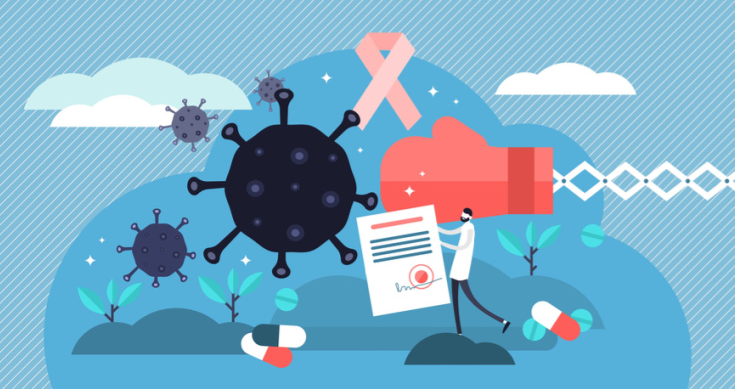by Dr Jenna Denyes – Healthcare Analyst
At the start of October, Merck and Ridgeback Biotherapeutics announced that their oral drug, molnupiravir, halves the risk of hospitalisation or death among those infected with Covid-19. The oral antiviral medication works by introducing mistakes into the viral ribonucleic acid (RNA) when it makes copies of itself, ultimately preventing the virus from making functional copies. In clinical trials, molnupiravir led to a 50% reduction in hospitalisation and no deaths, compared to eight deaths in placebo-treated patients, with no serious adverse effects.1,2Recruitment into the study is being stopped early due to the positive results and the firms are seeking emergency use authorisation in the US as soon as possible. The development is extremely encouraging. While there are highly effective antiviral antibody treatments available, which show a 70% reduction in hospitalisation, they need to be given in a hospital or clinic setting, as they are intravenous. Antiviral treatments that can be taken at home to keep people with Covid-19 out of the hospital are critically needed. Merck and Ridgeback Biotherapeutics’ encouraging efficacy data is also positive for two reasons: first, safe and effective antivirals are tremendously complicated to design; second, clinical trials for Covid-19 are extremely complicated to administer, as Roche and their partners Atea have unfortunately discovered.
On 22 October Roche and Atea announced that their promising anti-viral AT-527 failed to meet the primary endpoint in a Phase II ‘MOONSONG’ clinical trial.3 The oral therapy was highly promising because it inhibits viral replication in two different ways; reducing the likelihood of resistance, but also because it had an extreme safety profile, with no evidence of mutagenic adverse events. The clinical trial readout showed a 50% reduction in viral load; however, beyond that, there were complications. It is likely the trial failed for several reasons; including a changing variant landscape over the course of the trial, varying vaccination status and a wide patient population which would dilute the number of events. These complicated variables were also seen in several clinical trials for Covid-19 vaccines and highlights the intricate reality of drug development. It is entirely possible this drug would be useful in the real world, however it is hard at present to see the efficacy of the data through the noise. Roche and its partners have many ongoing trials which they can adjust and modify based on the learnings from MOONSONG. They remain convinced the mechanism of action will win out and ultimately reduce the severity of the course of the disease. We await readouts from Pfizer regarding their ongoing Phase III trial in high risk patients, which is expected before the end of the year.
In another positive development in the management of Covid-19, the US Food and Drug Administration (FDA) has approved booster shots for those at high risk either through age, underlying medical conditions or occupational exposure. Additionally, the mixing and matching of booster dosing from different manufacturers has been approved.4 Vaccine manufacturers have reported a wane in protection against mild to moderate infection after one year; however, the protection against hospitalisation and death remains strong. The booster shots will enable maximum protection for both the individual and the healthcare system, which is still struggling with the burden of pandemic patients alongside normal day-to-day operations. It will not be the first country to offer booster shots, but the positive recommendation is a strong signal the market and other countries have been waiting for.
The positive results from Merck, coupled with the promising results from Roche and the vaccine booster approval in the US, highlight the impressive progress the biotech and pharmaceutical industries have made in responding to the Covid-19 pandemic. In terms of prevention, there are now a handful of safe and effective vaccines approved across the world, with more than 6.75 billion doses administered as of 21 October. We will soon have further tools in the arsenal to treat the disease; adding oral molnupiravir to the currently available antiviral antibodies to treat the actual viral infection, as well as the varying anti-inflammatory and supportive treatments available for the severe inflammatory disease. Consequently, we can prevent most severe infections through a combination of vaccination and oral therapeutics, which should allow our healthcare systems to recover and the rest of the world to breathe a sigh of relief.
The development should also read through positively to markets. We have already seen attention shift away from Covid-19 news flow towards more typical macroeconomic concerns, which should continue. We have also seen this on a more focused level in the healthcare space. Companies and management have started to take a more strategic long-term view, illustrated by a rise in M&A activity. While it is hard to say anything with certainty these days, there seems to be a brightening light at the end of this pandemic tunnel.
ENDNOTES
2Painter W. P., et al 2021. Human safety, tolerability and pharmacokinetics of Molupiravir, a Novel broad-spectrum oral antiviral agent with activity against SARS-CoV-2. Antimicrobial ag and Chem. 65; 5: e02428-20.
3https://ir.ateapharma.com/news-releases/news-release-details/atea-pharmaceuticals-provides-update-and-topline-results-phase-2. Accessed 21 October, 2021.
4https://www.fda.gov/news-events/press-announcements/coronavirus-covid-19-update-fda-takes-additional-actions-use-booster-dose-covid-19-vaccines. Accessed 21 October, 2021








